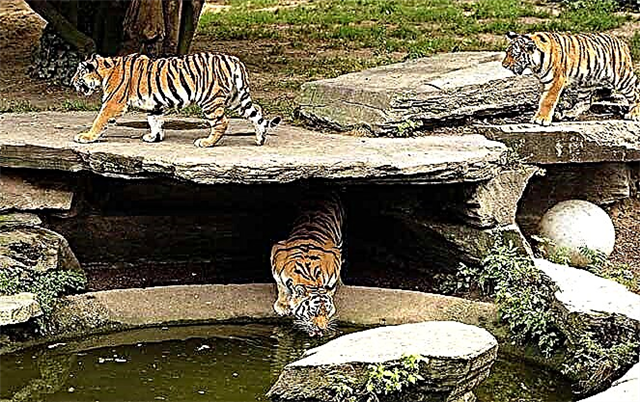Children's leisure time on trips abroad can be organized with the help of animators and guides, or the whole family can go to an entertainment center or a zoo. A visit to the zoo will not only help you have fun and enjoyment, but also teach kids a lesson about wildlife and its inhabitants. Zoos in Germany are considered one of the most visited in the world due to the safety and humane treatment of animals. About the best zoos, national parks in Germany and the mode of visiting them - further in this article.

Holidays with children in Germany
Germans love children, so they strive to make the period of childhood as colorful and memorable as possible. Thanks to government policy, every major city has a water park or water zoo, amusement parks and educational museums.
In Berlin, Munich, Hamburg, children's entertainment events are held annually, aimed at supporting tourism and attracting guests.
When traveling in Germany with your children, be sure to visit Legoland - a colossal amusement park located between Munich and Stuttgart, take a look at the German Technical Museum with interactive exhibitions and the Labyrinth Museum in Berlin, visit the Cottbus Zoo in Brandenburg. If you wish, take some time to the amusement park Europa Park, which contains attractions stylized as attractions from all over the world.
Warner Brothers Movie World is considered one of the best theme parks in the world - here you can chat with movie characters, ride rides, watch theatrical shows.
The most popular zoos in Germany
There are over 400 zoos in Germany, which welcome over 50 million visitors annually. Let's get acquainted with some of the oldest and most visited zoological parks in the whole country.
Wilhelm Zoo, Stuttgart
The second largest Wilhelm Zoo in Germany is part of a park complex established in the 1910s, which includes a botanical garden, aquarium, terrarium, food distribution and entertainment areas. The park ensemble, as of 2021, contains more than 8 thousand animals in conditions close to natural.

An exotic bird hatchery, similar to the poultry house at the Wuppertal Zoo, is one of the zoo's many attractions. Visitors can watch the chicks hatch, grow and develop.
Wilhelm Zoo is famous for its large population of primates, whose young were first born in captivity here. This complex hosts young animals of various animals abandoned by their parents, as local zoologists have unique experience in raising them.
Official website: www.wilhelma.de.
Opening hours depend on the season: the complex always opens at 08.15, in summer it closes at 20.00, and in winter it stops working at 16.00-18.00 - depending on when dusk falls.
There is public transport to the park complex: take the metro or take tram number U14 and get off at Rosenstein station. The zoo also has electric trains to the S-Bahn station.
The cost of an adult entrance ticket is 16 euros, for children (7-16 years old) - 8 euros, students and educators can get inside for 10 euros. For children under 6 years old, admission is free.
Leipzig Zoo
Leipzig Zoo has existed since the early 1870s. Today, more than 800 species of animals are represented on the territory of the complex. This family-friendly destination is an example of animal respect and an important center for development and research in the field of zoology.
The cages and aviaries at the Leipzig Zoo, which contain animals, have a unique design: they are made of stone, wood, glass and fit organically into the environment.
Official website: http://zoo-leipzig.de.
Address: st. Pfaffendorfer Str., 29.

An entrance ticket for adults will cost 19 euros, and a ticket for children from 6 to 17 years old - 9 euros. Group excursions are cheaper than individual ones - a group of four will be served for only 40 euros.
You can get to the zoo by any metro line (Wilhelm-Liebknecht-Platz station) or by tram S3 (Goerdelerring stop). A walk from the railway station to the complex will take no more than 10 minutes. Colored signs in the shape of funny animals will lead you to the zoological garden.
Cologne Zoo
The Cologne Zoo began operations in the 1860s and is primarily engaged in breeding and conservation work for primate populations. The staff also study animals that are endemic to Madagascar and the Mongolian area.
The aquarium, elephant enclosures, and the Cologne Zoo's tropical theme pavilion, which brings together birds and reptiles from the rainforest, attract millions of visitors every year.
Website: http://www.koelnerzoo.de.
Address: st. Riehler Str., 173.

The cost of the admission ticket for adults is 17.50 euros, for students - 12 euros. A ticket for children from 6 to 17 years old costs 8.50 euros, children under 6 years old are admitted free. There is a € 3 discount on all tickets on Mondays.
You can get to the zoo by metro line 18 (Ebertplatz station) or by bus number 140, which drives up directly under the gates of the zoological park.
Hannover zoo
The total area of the zoo reaches more than 22 hectares, which contains about 3 thousand individuals of different species. Most of the visitors are attracted by the Hanoverian population of elephants, of which 13 babies have already been born here.
The African Exposition is the most visited in the Hanover Zoo and includes birds, reptiles and mammals of the African continent.
Official website: http://www.zoo-hannover.de.

Address: st. Adenauerallee, 3. Contact phone number: 0511 280 740.
As of 2021, an adult entrance ticket costs 25 euros, a student ticket - 19 euros. Children from 6 to 17 years old will be admitted with a ticket for 17 euros, for children from 3 to 5 years old, the fare is 13.50 euros. Babies up to 3 years old are admitted free of charge.
You can get to this attraction by buses 128 and 134 (Zoo stop), tram number 11 or on a rental bike.
Hellabrunn Zoo, Munich
More than 17 thousand animals live on an area of 39 hectares. The zoological park is divided into conditional climatic zones and biotopes. Thanks to this, Hellabrunn has the status of a geo-zoo, the conditions of keeping animals in which are as close to natural as possible. Munich maintains an animal exchange program with Dresden.

Hellabrunn is one of the largest zoo complexes in the world and the most significant zoo in Europe, founded in the 1910s.
Website: http://www.hellabrunn.de/muenchner-tierpark-hellabrunn/.
Address: Tierparkstrasse, 30.
The price for an adult ticket is 15 euros, for children (from 4 to 14 years old) - 14 euros. Children under 4 years old are admitted free of charge. There is a subscription system that allows you to visit the zoo for a whole year for 49 euros (adults) or 25 euros (children).
The easiest way to get to the zoo is on the U3 metro line (get off at Tierpark station). Bus No. 52 also goes to the stop with the same name. If you took a tram, then you need to get off at Tiroler Platz.
Berlin Zoo
It is the oldest zoo complex in Germany, with a history of over 150 years. More than 1,500 species of animals live here, individuals - about 4 times more.
Berlin Zoo was founded in the early 19th century by King William IV. The excursion program in the zoological garden includes a visit to the castle on the territory.

Near the castle, outlandish birds and some ungulate mammals roam freely. The zoo enclosures are designed in such a way as to create the effect of being close to the animals.
Website: http://www.zoo-berlin.de.
Address: Zoologischer Garten station. Contact phone number: +49 (30) 254 010.
An adult ticket for a visit costs 15.50 euros (21 euros for those who want to additionally visit the aquarium), children - 8 euros (+ 2.5 euros per aquarium), student - 10.5 euros (15.5 euros with an aquarium) ...
You can get to the zoo by metro lines U2, 9, 12, by electric trains S5, 7, 9, 75. Get off at the Zoologischer Garten station.
Nuremberg Zoo, Bavaria
One of the few zoological gardens, which is not located within the city, but in a separate forest near Nuremberg. The vast area of the zoo is home to more than 300 species of animals that live in their natural conditions.

The Nuremberg Zoo opened in 1912, but was damaged during the Second World War and only resumed operations in the 1950s. The zoological park is home to both tropical animals and Central European species. The complex also has bird ponds.
Website: http://tiergarten.nuernberg.de.
Address: Am Tiergarten, 30.
The ticket price is fixed: adults have to pay 13.50 euros, the cost for children from 4 to 13 years old is 6.50 euros.
"Zoological Garden" - the terminal station of the city train line S5.
Zoos in other cities in Germany
German zoos are considered some of the best in the world due to their tolerant attitude towards animals and the colorful, tourist-oriented exhibits. Almost every large and medium-sized city has its own and sometimes more than one zoo.
When traveling in Germany, it is worth visiting the Dortmund Zoo, zoos in Osnabrück, Hamburg, Karlsruhe, Wuppertal, Aachen and Augsburg Zoos.
| Zoo | Address | Schedule | Ticket price |
|---|---|---|---|
| Heidelberg Zoo | Heidelberg, Tiergartenstrasse, 3 | April-October - from 09.00 to 19.00; November-March - from 09.00 to 18.00 | Children from 3 to 8 years old - 5.10 euros, students - 7.70 euros, adults - 10.20 euros |
| Duisburg Zoo | Duisburg, Mülheimer Str., 273 | Without breaks and days off from 09.00 to 19.00 | Children from 3 to 17 years old - 9.90 euros, students - 14.90 euros, adults - 16.90 euros |
| Zoo Gelsenkirchen | Gelsenkirchen, Bleckstraße 64 | Without breaks and days off from 09.00 to 18.30 | Children from 4 to 12 years old - 14 euros, students - 16 euros, adults - 21.50 euros |
| Zoo in Münster | Münster, Sentruper Str., 315 | Without breaks and days off from 09.00 to 18.00 | Children from 3 to 8 years old - 10.90 euros, students - 12.90 euros, adults - 18.90 euros |
| Zoo Kronberg | Kronberg, Am Opel-Zoo, 3 | Without breaks and days off from 09.00 to 19.00 | Children from 3 to 17 years old - free, students - 7.50 euros, adults - 14 euros |
| Augsburg Zoo | Augsburg, st. Brehmpl, 1 | Without breaks and days off from 09.00 to 18.30 | Children from 3 to 15 years old - 7 euros, adults - 14 euros |
National parks and nature reserves in Germany
Since the Germans respect the environment and do everything possible to preserve it, national reserves in Germany are unusually developed. Wild forests, landscape parks, mountain ranges - huge tracts of untouched land are set aside for nature conservation areas.
If you plan to explore German national parks, start your journey at the country's first reserve, the Bavarian Forest, located in Bavaria.
The Lanzscher Park of Düsseldorf, the Meissen Landscape Park by the Elbe River and the Jasmund Park are worth visiting. The Hamburg Watts - rich islands and lands on the shores of the North Sea - deserve a separate trip.
Finally
Organizing children's leisure time in Germany is a simple and exciting task. It is enough to find out where the nearest zoo is along the way and spend an unforgettable day in communication with its inhabitants. Plan your trip in advance, find out the location of the zoo complexes, their opening hours and the cost of entrance tickets, in order to get only positive emotions from the trip.











